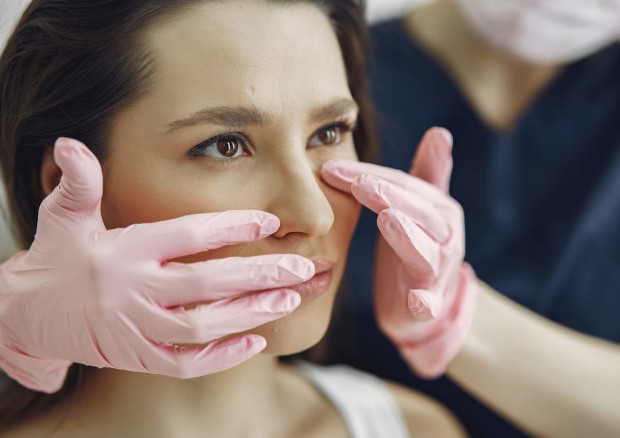Rhinoseptoplasty surgery

specialists

equipment

treatment
Indications for rhinoseptoplasty

Rhinoseptoplasty in the clinic is performed in the presence of a deviated nasal septum. In particular, surgery is prescribed if chronic sinusitis is observed against the background of a deviated nasal septum.
There are also aesthetic indications for septum correction:
- Discrepancy between the size or shape of the nose and the general proportions of the face
- Irregularities in the contour of the nose
- Dissatisfaction with the shape or size of the tip of the nose
- Asymmetry or visible defects of the nose
Rhinoseptoplasty of the nose in Moscow is also recommended after serious injuries that have resulted in deformation of the nose.
We perform rhinoseptoplasty inexpensively. Check the current cost of rhinoseptoplasty in our center by phone.
Contraindications to surgery

The procedure is not prescribed to people under 18 years of age. This is due to the fact that any changes can affect the further growth and development of the facial skeleton. Additional contraindications:
- Chronic diseases (cardiovascular pathologies, diabetes)
- Blood clotting disorders
- Uncontrolled mental illnesses (psychoses)
- Acne on the nose
The operation is also contraindicated for people with allergic reactions.
Types of Rhinoseptoplasty
Open rhinoseptoplasty
In the process of open rhinoseptoplasty, the surgeon separates the nostrils. This allows him to fully open the nasal area and gain greater access to its structures.
This operation on the nasal septum is used to correct complex defects. Its main disadvantages are the presence of noticeable marks (scars) and a long recovery period.
Closed Rhinoseptoplasty
Which rhinoplasty method is better?
The choice of rhinoseptoplasty method depends on many factors. Before performing such septoplasty of the nose, the specialist first of all takes into account the anatomical features of the patient.
A comparison of nasal septum surgery methods is presented in the table.
| Characteristics | Open rhinoseptoplasty | Closed rhinoseptoplasty |
|---|---|---|
| Technique of execution | Incision on the columella, skin peeling to access the structures of the nose | Incisions inside the nostrils |
| Advantages | Good visibility of the structures of the nose, improved modeling | No visible scars in the nasal area, short recovery period |
| Disadvantages | Possible visible scar, longer recovery | Limited access and visibility, technical complexity |
The prices for different types of rhinoseptoplasty also vary. Open rhinoplasty is considered a more complex procedure. For this reason, the price of such rhinoseptoplasty is higher than the cost of closed surgery.
General information about the procedure
Recommendations after rhinoseptoplasty
For successful recovery and minimization of risks of complications after surgery, it is necessary to strictly follow the doctor's recommendations.
During the first week, it is necessary to avoid physical activity: do not strain or bend over. Returning to normal activities is allowed 2-3 weeks after the intervention. At the same time, intense physical activity and sports should be avoided for 4-6 weeks.
In addition, after the operation, it is necessary to take all prescribed medications and attend follow-up examinations with the surgeon.

The basic requirements are as follows:
- Avoid getting your nose wet Avoid getting the plaster cast or splints wet for the first week. Use wet wipes or a sponge when washing
- Avoid tobacco and alcohol for 2-3 weeks after the procedure Nicotine and alcohol use slows down the healing process
- Monitor your diet To reduce the risk of swelling, avoid very salty and spicy foods
- Avoid wearing glasses To avoid putting pressure on your nose, avoid wearing glasses for the first 4-6 weeks after rhinoseptoplasty
Answers to popular questions
Here you will find information about surgical correction of nasal defects. In particular, you will learn how to prepare for the operation and where you can undergo it.
What is the difference between rhinoplasty and septoplasty?
What tests should be taken before surgery?
What should not be done after septoplasty?
Where to go?

How is an appointment with an otolaryngologist at K+31?
Our doctors

This award is given to clinics with the highest ratings according to user ratings, a large number of requests from this site, and in the absence of critical violations.

This award is given to clinics with the highest ratings according to user ratings. It means that the place is known, loved, and definitely worth visiting.

The ProDoctors portal collected 500 thousand reviews, compiled a rating of doctors based on them and awarded the best. We are proud that our doctors are among those awarded.
Make an appointment at a convenient time on the nearest date
Price






































What is rhinoseptoplasty?
This operation allows you to change the size of the nose, its profile, the shape of the tip or nostrils.
Rhinoseptoplasty also solves problems associated with the nasal septum. This is the internal wall that divides the nasal cavity into two parts. A deviated septum causes difficulty breathing. In addition, diseases of the nose and ears often develop against the background of a deformed septum.